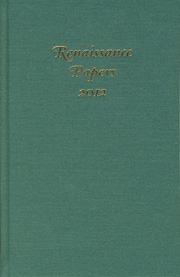Book contents
- Frontmatter
- Contents
- Dedication
- Reconstructing the Bower of Bliss: Homoerotic Myth-Making in The Faerie Queene
- Ovid, Lucretius, and the Grounded Goddess in Shakespeare's Venus and Adonis
- The Soul as Commodity: Materialism in Doctor Faustus
- Antipholus and the Exorcists: The Acts of the Apostles in Shakespeare's The Comedy of Errors
- Paul's Cross Churchyard and Shakespeare's Verona Youth
- The Summoning of Hamlet and Lear
- “Bred Now of Your Mud”: Land, Generation, and Maternity in Antony and Cleopatra
- Cosmetic Blackness: East Indies Trade, Gender, and The Devil's Law-Case
- From One Marvell to Another: Puritan Logic in “To His Coy Mistress”
- “An Heap Is Form'd into an Alphabet”: Thomas Blount's Sociable Lexicography
- Getting Past the Ellipsis: The Spirit and Urania in Paradise Lost
Reconstructing the Bower of Bliss: Homoerotic Myth-Making in The Faerie Queene
Published online by Cambridge University Press: 05 December 2013
- Frontmatter
- Contents
- Dedication
- Reconstructing the Bower of Bliss: Homoerotic Myth-Making in The Faerie Queene
- Ovid, Lucretius, and the Grounded Goddess in Shakespeare's Venus and Adonis
- The Soul as Commodity: Materialism in Doctor Faustus
- Antipholus and the Exorcists: The Acts of the Apostles in Shakespeare's The Comedy of Errors
- Paul's Cross Churchyard and Shakespeare's Verona Youth
- The Summoning of Hamlet and Lear
- “Bred Now of Your Mud”: Land, Generation, and Maternity in Antony and Cleopatra
- Cosmetic Blackness: East Indies Trade, Gender, and The Devil's Law-Case
- From One Marvell to Another: Puritan Logic in “To His Coy Mistress”
- “An Heap Is Form'd into an Alphabet”: Thomas Blount's Sociable Lexicography
- Getting Past the Ellipsis: The Spirit and Urania in Paradise Lost
Summary
Erotic encounters between women appear with surprising frequency in the middle books of The Faerie Queene. Both Guyon's adventure in the Bower of Bliss and Britomart's encounters with Malecasta and Amoret reflect Renaissance beliefs about female-female desire. Spenser consistently associates heterosexual intercourse with sexual maturity: his treatment of homoerotic desire as an “adolescent” stage of development adheres to early modern myths regarding same-sex attraction. Indeed, one of Spenser's goals in the middle books of The Faerie Queene seems to be discouraging women's non-teleological, non-reproductive eroticism, and encouraging them to “move forward” into a reproductive sexual marriage. The homoeroticism that fills Spenser's garden of sexual delight motivates Guyon's wrathful destruction of Acrasia's Bower—a destruction that points toward the potential threat of feminine stasis in non-reproductive sexual activity. In addition, Britomart's sexual encounters with other women become both a primary challenge to the lady Knight's quest and a central element of her sexual education as she learns to embrace her role as a mother and wife.
Reconstructing the Bower of Bliss
Spenser's Bower of Bliss is a space of feminine sexual autonomy. Although critics once viewed the sexuality displayed in the Bower as a show that exists only for Guyon, describing it as a realm of lust devoid of sexual fulfillment, a world of pornographic show as opposed to one of sexual satisfaction, more recent readings acknowledge the rampant female sexuality of the Bower. Only Guyon sees a show without sexual satisfaction. Indeed, the women in the fountain who “wrestle wantonly” are enjoying lust in action (2.12.63). Acrasia repeatedly “bedew[s] Verdant’s lips . . . with kisses light” and “sucke[s] his spright,”—considering the early modern connection between “spright” and “semen,” Acrasia is obviously engaged in sexual activity and satisfying her lust (2.12.72). For the women fondling each other in the fountain, and for Acrasia and Verdant, the Bower contains sex: the reader only sees a show if he or she looks through the eyes of the voyeuristic Guyon. Indeed, Spenser invites such a perspective: the Bower is full of references to eyes and sight.
- Type
- Chapter
- Information
- Renaissance Papers 2012 , pp. 1 - 12Publisher: Boydell & BrewerPrint publication year: 2013

